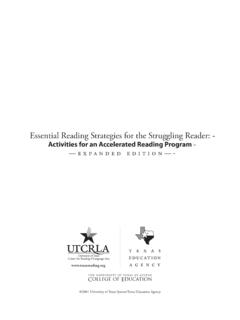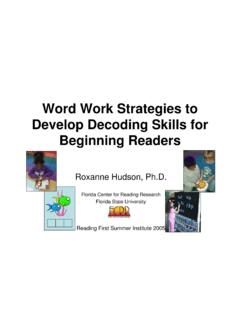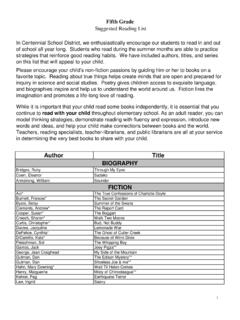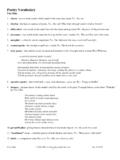Transcription of Word Lists for Vocabulary Learning and Teaching - ERIC
1 The CATESOL Journal 2012/2013 287 Word Lists for Vocabulary Learningand TeachingWithin the communicative approach, often the assumption has been that with the right exposure, students will simply pick up the Vocabulary required for Learning and using English, and thus there is no need to focus on or teach it. Yet, as many teachers can attest, this is frequently not the case, and there have been recent efforts to reemphasize Vocabulary Learning and Teaching in both research and practice. This article surveys the literature on word Lists for Vocabulary Teaching in English as a second/foreign lan-guage (ESL/EFL), especially for adults, briefly summarizing their potential for learners and teachers in Learning and Teaching Eng-lish Vocabulary . After discussing general and academic word Lists , it introduces contributions from recent corpus research resulting in 2 Lists of English formulaic expressions and 8 subject-specific English word Lists , in fields varying from agriculture, business, and engineering to medicine and theology.
2 Finally, it offers suggestions for their potential in Vocabulary time ago, Meara (1980) called Vocabulary a neglected aspect of second and foreign language (L2/FL) Learning . Thankfully this situation has changed, and in the last several decades a significant amount of re-lated pedagogical research has appeared (see, , Carter, 2012; Folse, 2004, 2011a; Lessard-Clouston, 2013; McCarthy, O Keefe, & Walsh, 2010; Nation, 2001, 2011; Nation & Webb, 2011; Schmitt, 2008, 2010; Schmitt & Schmitt, in press; Zimmerman, 2009), as well as research-based ESL/EFL textbooks ( , Folse, 2011b; Kinsella, 2013; Schmitt, Schmitt, & Mann, 2011; Wells & Val-court, 2010). Yet in recent research in various types of ESL classes Folse (2010) concluded that Vocabulary is indeed still neglected by many teachers, as the amount of explicit Vocabulary focus in a week of classes he observed was sur-prisingly low (p.)
3 139). This is a disturbing finding, given two challenges ESL/EFL students face: the large quantity of English Vocabulary and complex quali-tative issues in mastering word knowledge and use (Laufer & Nation, 2012). As I shall discuss, English word Lists are one key resource available to they are seemingly pass or uncommon in ESL education (Folse, 2004), word Lists are frequently used in many English as a foreign language MICHAEL LESSARD-CLOUSTONB iola University288 The CATESOL Journal 2012/2013(EFL) contexts. Schmitt s (1997) study on the Vocabulary - Learning strategies of Japanese EFL students, for example, reported that the majority of respon-dents used word Lists to learn English Vocabulary , particularly junior high and high school students (67%) and university students (50%).
4 Anecdotally, learn-ers from other Asian contexts report similar patterns of use, and the question remains if teachers in more ESL/EFL contexts might make good use of word Lists for students Learning and their communicative language Teaching , Vocabulary Learning has tended to be done incidentally, though in recent years there has been a call for more explicit Teaching of words and Vocabulary - Learning strategies (Zimmerman & Schmitt, 2005). One challenge with English is its huge Vocabulary , which requires focus and some guidelines in order to help students develop greater word knowledge so that they might use Vocabulary items effectively. In research with undergraduates and graduates, time and again studies have indicated that ESL/EFL students lack essential Vocabulary knowledge not just for reading, but also for listening, speaking, and writing in English ( , Liu & Nesi, 1999; Na-tion & Waring, 1997; Nurweni & Read, 1999; Ward, 1999, 2009a).
5 One way to approach the question of what Vocabulary to teach is to consider existing principled Lists of English words , research related to their use, and our students interests, needs, and goals. In this article I survey relevant research, briefly introduce general and academic word Lists , two for collocations, and several subject-specific ones, and offer some suggestions for their potential : Some Context From the LiteratureIn considering English word Lists , one issue to examine is the teacher s situ-ation, and if it is a more general, academic ( , English for Academic Purpos-es, EAP) or specific (English for Specific Purposes, ESP) English Learning and Teaching context. Another concern addresses the interests and needs of one s students, given their particular goals for Learning and using English.
6 I begin the discussion with the most well-known English Vocabulary Lists , the General Service List (GSL) for the most frequent English words overall, and two Lists for academic general, all-purpose English usage, West s (1953) GSL is now some-what dated, but it is still the best general-purpose list we have for addressing the most frequent words in English. As Gilner (2011) notes in her helpful primer on it, the GSL is actually a reissue of Faucett, Palmer, Thorndike, and West s (1936) report on English Vocabulary selection that came out after two inter-national conferences on the role of word Lists for EFL education. Introducing the 2,000-item GSL of the most frequent and wide-ranging words in English, Gilner (2011) declares:Over 100 years of analyses of English corpora unequivocally agree on the fact that relatively few words amount for most of the Vocabulary used.
7 Ap-proximately 2,000 words account for 70% to 95% of all running words re-gardless of the source of the text. (p. 65)So, whether one is reading a newspaper, a novel, a textbook, or an academic The CATESOL Journal 2012/2013 289journal article, or listening to a lecture or a radio or television program, most (on average 82% according to Nation & Waring, 1997) of the words one en-counters will be found on this list. The GSL is further divided into the first and second most frequent 1,000 English words , listed alphabetically, and has been used for many years in creating ESL/EFL Teaching materials, including graded readers. As Gilner (2011) states, despite some criticism (mainly of its age, see Richards, 1974) it has withstood the test of time and continues to be the best all-purpose list of general English Vocabulary , based on frequency and range, for widespread use.
8 All ESL/EFL students should thus be familiar with and flu-ent in using GSL Vocabulary , covering common English for academic Vocabulary , two Lists exclude items from the GSL but re-flect frequent academic English Vocabulary appearing in and used across vari-ous disciplines. Xue and Nation s (1984) University word list (UWL) is made up of 836 items (such as accompany, ignore, indicate, occur, etc.) and represents on average about coverage of the words in academic texts (Nation & War-ing, 1997). It is both an alphabetical list and a compilation of 11 sublists, draw-ing on previous Lists of academic English Vocabulary in New Zealand and the US. In more recent years, Coxhead s (2000) Academic word list (AWL) has essentially come to replace the UWL, as the AWL was created using a corpus of texts from four disciplines (arts, commerce, law, and science) from the college and university level.
9 The AWL includes 570 items, but has coverage similar to that of the UWL in most academic texts. Like the UWL, the AWL is divided into 10 sublists according to frequency, but it may also be alphabetized (as, for example, in Appendix 2 of Nation, 2008). Although earlier ESL/EFL materials for academic purposes relied on the UWL, in the last decade most textbooks (including those noted earlier) have used the AWL, although the GSL is also common for such the availability of these three principled word Lists , what has re-search shown about them and their use in Teaching English? Shillaw s (1995) brief anecdotal report noted that he used the GSL with EFL students in Japan for 1 semester and reported that his students chose words to focus on from it and were thus able to learn some 300 words as they attended classes, read the graded reader Cry Freedom, and later watched and discussed the movie of that title.
10 Van Benthuysen (2003) similarly reported positive results in using the UWL with 14 Japanese EFL college students over 9 months. His students were preparing to take the TOEFL and to go abroad to study, so focusing on the 11 sublists on the UWL (about 75 words each) seemed useful to his highly motivated students. He gave them one of the sublists every 2 weeks, along with example sentences. Students were expected to learn the words by themselves, and could practice them in their writing, but then they had a multiple-choice test on each sublist every 2 weeks. Using a pre- and post-session Vocabulary Levels Test (from Nation, 1990), Van Benthuysen s students showed the most Vocabulary growth on the UWL section of the test at the end of their the two examples above deal with the GSL and the UWL, further re-search has also been carried out with other word Lists in other contexts.



















